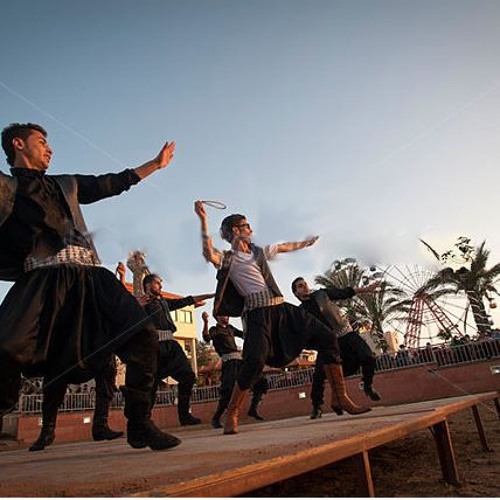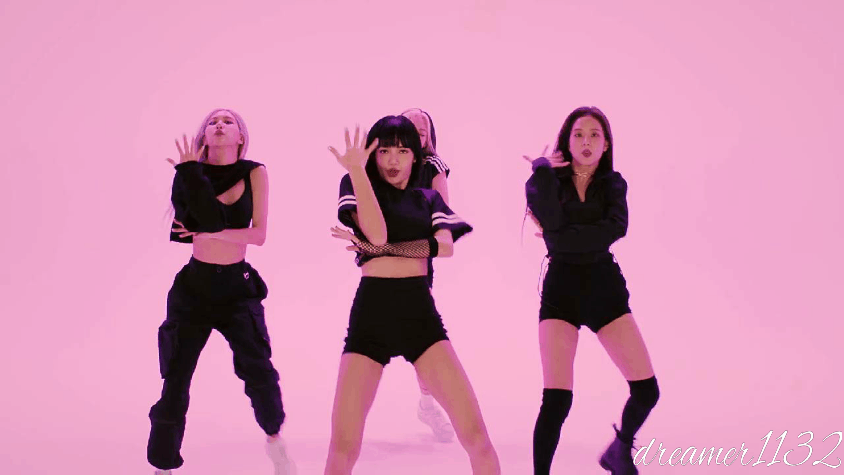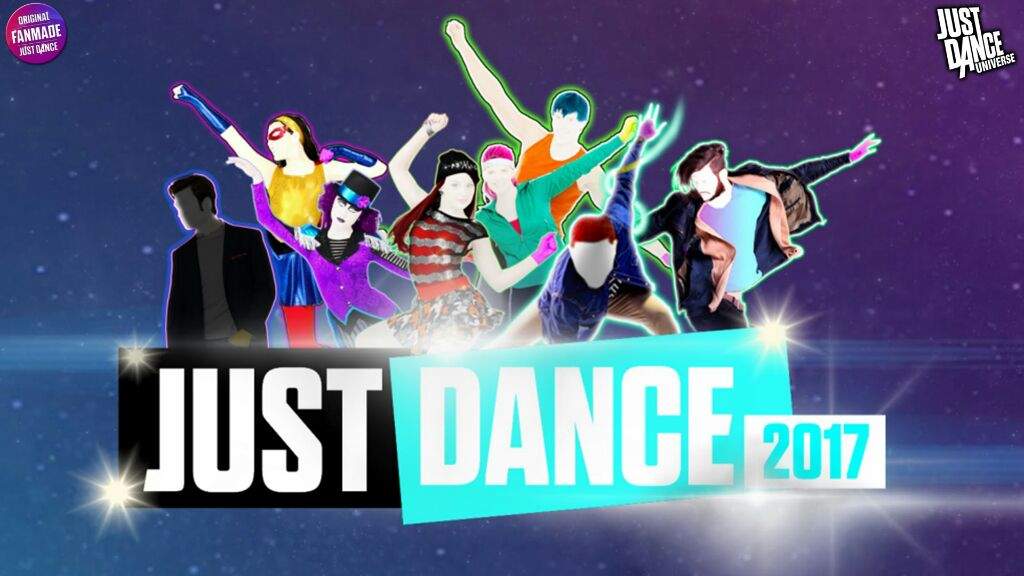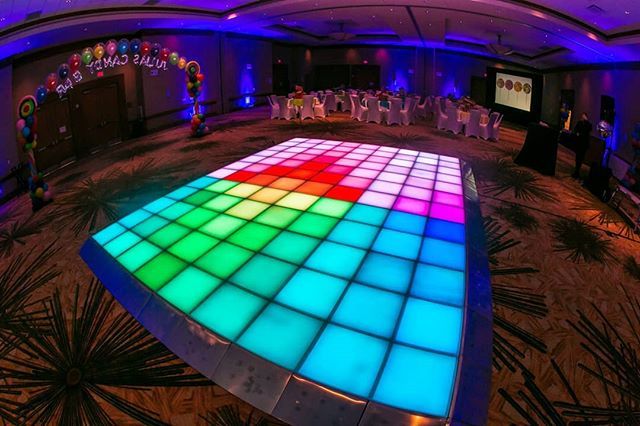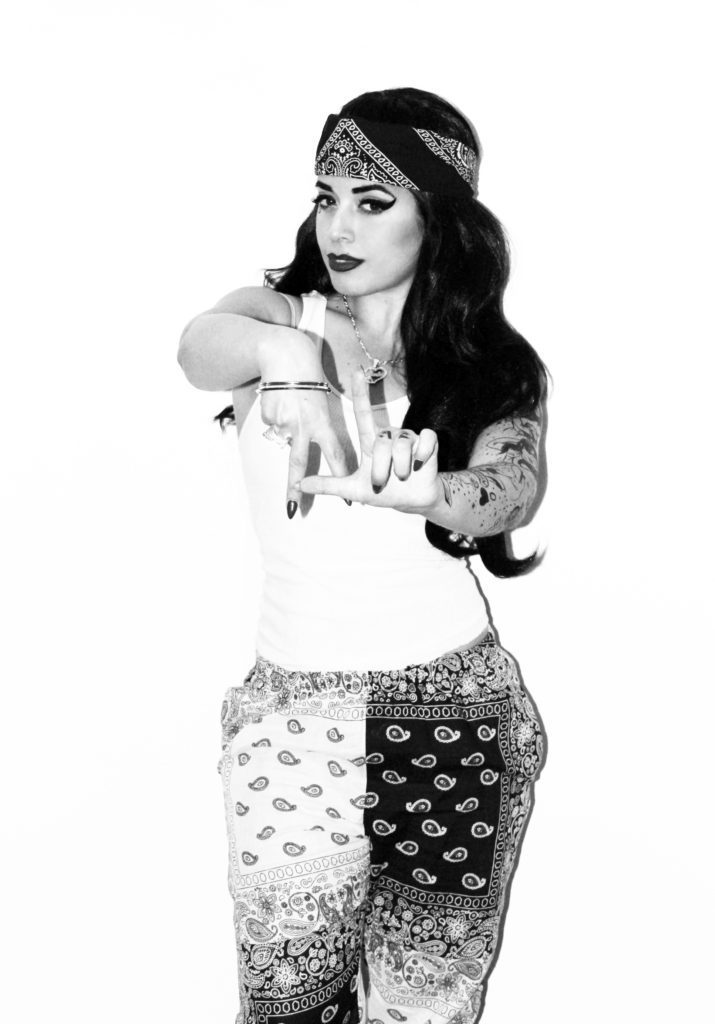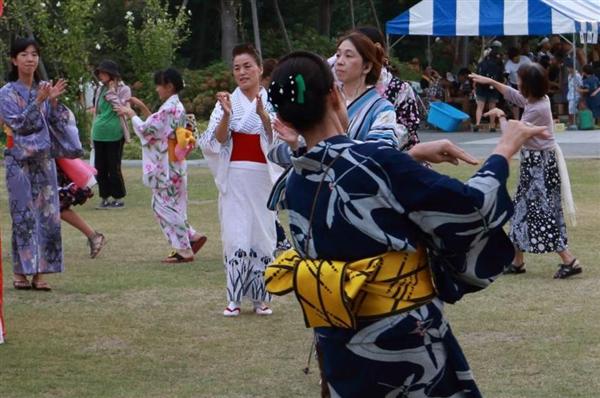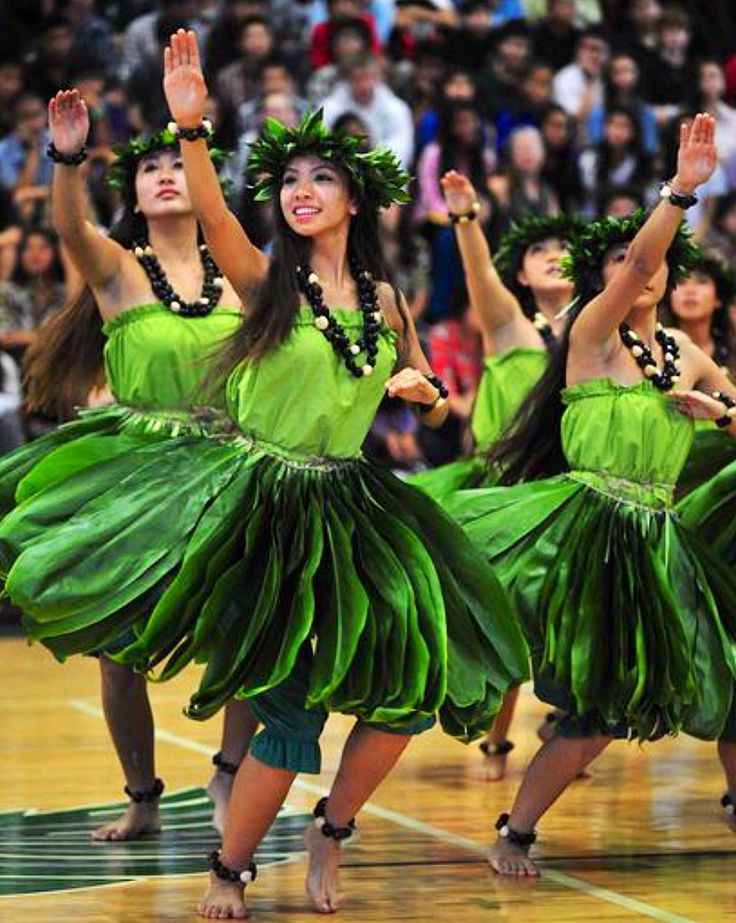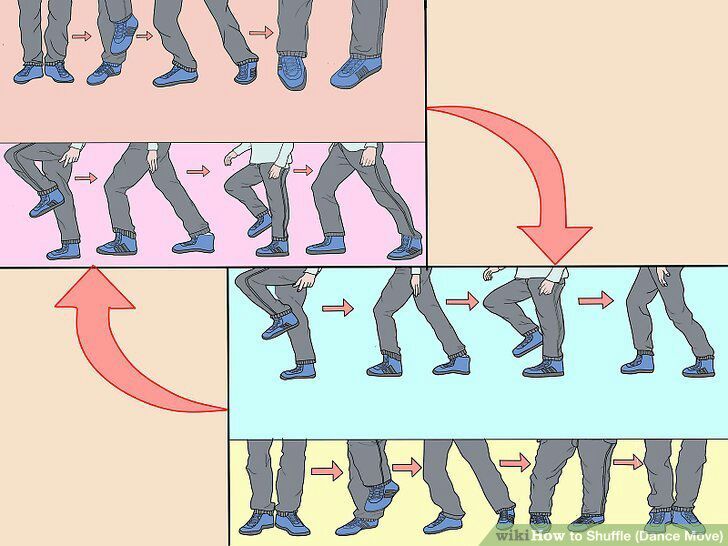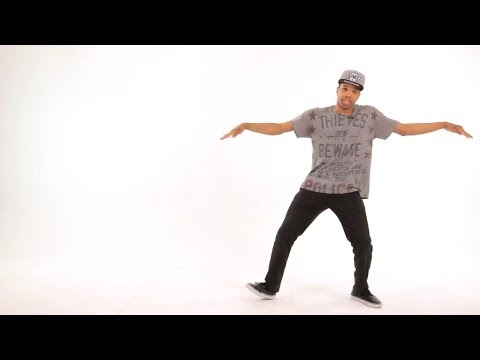How to dance dabke
Dabke (L*), Debke – Lebanon, Palestine, Syria, Jordan – Revised and Expanded – Folkdance Footnotes
*a Living dance is a 1st Generation dance that is still performed in the country of origin (or immigrant communities) as part of a social event like a wedding where others can participate (not for an audience) by people who learned the dance informally (from friends and relatives by observation and imitation, not in a classroom situation). For more information, click here and here.
About Dabke
Dabke, Debke, is THE dance genre of the Levant – Syria, Lebanon, Jordan, Palestine, and parts of Israel, Iraq, Turkey, Yemen, and Saudi Arabia. I say dance genre because, although there is one basic step that is typical of the most popular type of dabke, there are many types of dabke, some of which have other basic steps. Furthermore, many Levantine people label any long-line, mixed gender, simple group dance a dabke, including dances by Assyrians, Kurds, Turks and others who do not have dabke in their tradition. Beware of YouTubes labeled Dabke!
Generally speaking, when Levantines speak of dabke, they mean a dance where everyone can participate, but where the line has 3 distinct parts.
- 1. The raas (“head”) or lawweeh (also spelled “lawih”) who leads the line; an accomplished dancer who inspires and directs the line, and may improvise sometimes spectacular steps, leaps, twists, and other acrobatic moves.
- 2. The next 2 or 3 people in line – trusted partners who can support the leader by anticipating and copying the leader’s moves, or physically support the leader when the leader leaps, drops, leans, etc.
- 3. Everybody else, who are there to witness and enjoy participating in a group event, and to dance a simple step, which may change occasionally at the leader’s direction.
 https://www.youtube.com/watch?v=HYxQMbsmPaw
https://www.youtube.com/watch?v=HYxQMbsmPawNote the basic dabke step has 6 counts or steps and moves to the right. Some folk dance scholars note a similarity between dabke and a more universal 6-count line dance – what I term the Taproot Dance. For more on this dance click https://folkdancefootnotes.org/begin/the-taproot-dance/. I don’t consider dabke a Taproot Dance because it lacks the “2 to the right, 1 to the left ” direction pattern and also lacks the “step, step, step,___ step___,” pattern of weight shifts – both are essential elements of Taproot. The essential element of dabke is a STAMP, and also, usually, many more steps with the left foot than the right. The ‘basic’ above, for instance is cross step left, right, cross step left, right, lift left, stamp left.
According to Lebanese historian Youssef Ibrahim Yazbec, the dabke descends from Phoenician dances thousands of years old. [6] The dabke jumps may have originated in ancient Canaanite fertility rituals related to agriculture, chasing off evil spirits and protecting young plants.[7]
[6] The dabke jumps may have originated in ancient Canaanite fertility rituals related to agriculture, chasing off evil spirits and protecting young plants.[7]
Here’s a Lebanese documentary, explaining what Dabke means to the people of the Levant.
The etymology of dabke is uncertain, but it is thought to be derived from the Levantine Arabic word dabaka (Arabic: دبكة) meaning “stamping of the feet”[3][4][5] or “to make a noise”.[6]
The legend of dabke‘s origin.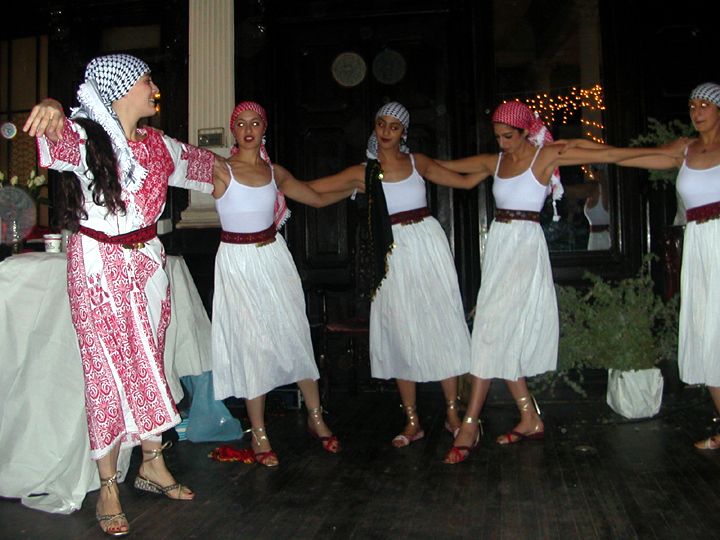 https://www.youtube.com/watch?v=CrTmWh8-fI0 This YouTube is an excerpt from a longer YouTube about the Syrian community of Argentina, found here: https://www.youtube.com/watch?v=syRa2Lsq1C4
https://www.youtube.com/watch?v=CrTmWh8-fI0 This YouTube is an excerpt from a longer YouTube about the Syrian community of Argentina, found here: https://www.youtube.com/watch?v=syRa2Lsq1C4Found here: https://dabka2.blogspot.com/: The leader, called raas (“head”) or lawweeh (also spelled “lawih”) which means to wave, is allowed to improvise on the type of dabke. The leader twirls a handkerchief or string of beads known as a masbha (similar to a rosary), while the rest of the dancers keep the rhythm. Hands are joined together in a palm to palm clasp or by linking pinkies. Arms are held straight down at the sides or can be slightly bent (if the hands are clasped correctly). Shoulders are very close to one another. The physical closeness creates an experience of cultural unity. The movements are synchronized. Uniform movements are what make a debke successful. The dancers also use vocalizations to show energy and keep up the beat.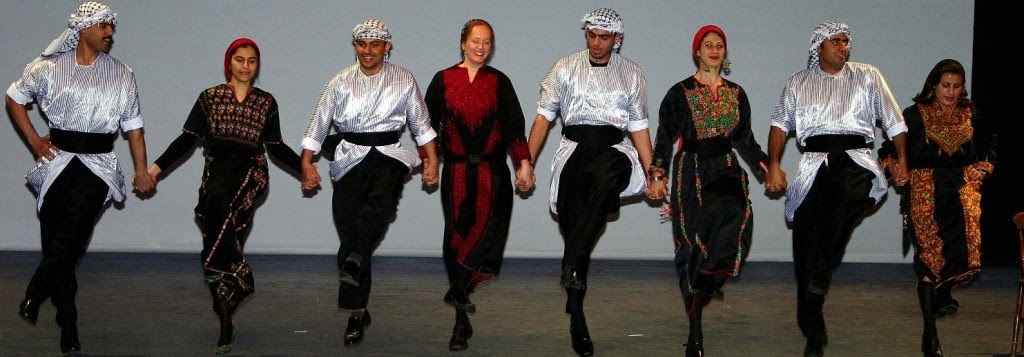 The dabke leader is supposed to be like a tree, with one arm in the air, a proud and upright trunk, and feet that stomp the ground in rhythm. At weddings, the singer begins with a mawwal. The raas or lawweeh takes the lead. Everyone does a basic 1-2-3 step before the song kicks in. At weddings, the dance is sometimes performed by a professional troupe dressed in costume.
The dabke leader is supposed to be like a tree, with one arm in the air, a proud and upright trunk, and feet that stomp the ground in rhythm. At weddings, the singer begins with a mawwal. The raas or lawweeh takes the lead. Everyone does a basic 1-2-3 step before the song kicks in. At weddings, the dance is sometimes performed by a professional troupe dressed in costume.
Song Genres There are numerous kinds of songs that are sung during and specifically for dabke, by both men and women respectively, depending on the occasion, song, and audience. Some of the most popular of these songs, such as Dal Ouna (دلعونا), Al Jafra (الجفرا), Al Dahiyya (الدحية), and Zareef il-Tool (ظريف الطول), are actually entire genres in themselves, in the sense that lyrics can vary significantly in each performance but the basic rhythm of the music is consistent and recognizable. This variation can be seen in the hundreds of lyrical variations heard and recorded of these songs which regardless of specific lyrics, are recognized by their rhythm and at times, a single phrase, as in Ala Dal Ouna, Jafra, and others. For example, even though one might have heard Ala Dal Ouna sung previously telling a different story in this famous love song, people will still call another song ascribing to the same rhythm and theme as Dal Ouna.
For example, even though one might have heard Ala Dal Ouna sung previously telling a different story in this famous love song, people will still call another song ascribing to the same rhythm and theme as Dal Ouna.
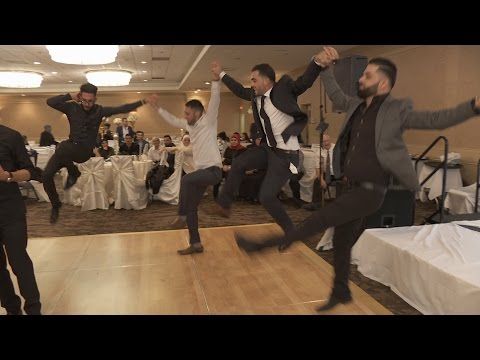 This recording is not the actual wedding, but a so called “Sahra”, which take places the night before. https://www.youtube.com/watch?v=PTfgwxIzC_4Simple wedding dabke‘s are harder to find. https://www.youtube.com/watch?v=JnBszWEQiO0
This recording is not the actual wedding, but a so called “Sahra”, which take places the night before. https://www.youtube.com/watch?v=PTfgwxIzC_4Simple wedding dabke‘s are harder to find. https://www.youtube.com/watch?v=JnBszWEQiO0Wikipedia says there are about 20 different types of Dabke, of which six are main types. I tried Googling each type, and found only a couple of YouTubes with these labels.
- Al-Shamaliyya (الشمالية): is probably the most famous type of dabke. It consists of a lawweeh (لويح) at the head of a group of men holding hands and formed in a semicircle. The lawweeh is expected to be particularly skilled in accuracy, ability to improvise, and quickness (generally light on his feet).
 Typically, the dabke begins with a musician playing a solo on the mijwiz or yarghoul of a Dal Ouna piece, often with two singers accompanying his music. The dancers develop a synchronized movement and step and when the singers finish their song, the lawweeh breaks from the semicircle to dance on his own. When the leader of the dabke sees that the men’s steps are one, in sync, he instructs the dancers to slow down and begin a movement crossing their right foot in front of the opposite one (their left foot). The lawweeh continues to inform the dancers of their basic rhythms, and at this point other guests at the wedding or event occurring will join in the dabke line. This is the most popular and familiar form of dabke danced for happy family celebrations, such as weddings, circumcisions, the return of travelers, release of prisoners, and also for national holidays, in which dabke becomes a demonstration of national personality.[10]
Typically, the dabke begins with a musician playing a solo on the mijwiz or yarghoul of a Dal Ouna piece, often with two singers accompanying his music. The dancers develop a synchronized movement and step and when the singers finish their song, the lawweeh breaks from the semicircle to dance on his own. When the leader of the dabke sees that the men’s steps are one, in sync, he instructs the dancers to slow down and begin a movement crossing their right foot in front of the opposite one (their left foot). The lawweeh continues to inform the dancers of their basic rhythms, and at this point other guests at the wedding or event occurring will join in the dabke line. This is the most popular and familiar form of dabke danced for happy family celebrations, such as weddings, circumcisions, the return of travelers, release of prisoners, and also for national holidays, in which dabke becomes a demonstration of national personality.[10] - Al-Sha’rawiyya (الشعراوية): is limited to men and is characterized by strong steps or stomps.
 The lawweeh is the most important element in this type of dabke.[10]
The lawweeh is the most important element in this type of dabke.[10] - Al-Karaadiyya (الكرادية): is characterized by a lack of a lawweeh and slow movement with an azif (عازف) (flute player) in the middle of the circle.[10]
- Al-Farah (الفره): is one of the most active types of dabke and therefore requires a high degree of physical fitness.[10]
- Al-Ghazal (الغزل): is characterized by three strong stomps of the right foot, and is usually tiring for those dancing.[10]
- Al-Sahja (السحجة): is a popular Palestinian and Jordanian dance which became significantly more popular during the British Mandate for Palestine. Al-Sahja belongs mostly to northern and central Palestine, and in the south has two kinds: As-Samir (السامر) and Al-Dahiyya (الدحية). As-Samir’s form involves 2 rows of men on opposite walls, competing with folk poetry, sometimes improvised and even exchanging insults, competing in cleverness of retorts.
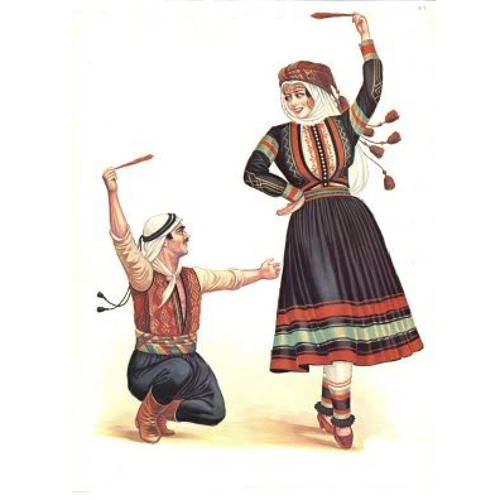 Al-Dahiyya is a Bedouin version of the same kind in which there is a professional dancer that dances between the two opposing walls of men who are competing for her attention, and at times give her money. Al-Sahja usually occurs the night before the wedding party of the groom (zafat al-‘arees), with most of the men in the village participating, especially those who will be attending or are directly involved in the other wedding festivities.”
Al-Dahiyya is a Bedouin version of the same kind in which there is a professional dancer that dances between the two opposing walls of men who are competing for her attention, and at times give her money. Al-Sahja usually occurs the night before the wedding party of the groom (zafat al-‘arees), with most of the men in the village participating, especially those who will be attending or are directly involved in the other wedding festivities.”
Lately the dabke has become more of a performance dance where a group of friends practice constantly until they can do complex steps in unison, then perform at weddings and celebrations. Most of the dabke YouTubes seen today are of this type – people want to see the most spectacular moves.
A sampler of current masters https://www. youtube.com/watch?v=_OeI00gA5ugAnother (rival) master Tamer Akil https://www.youtube.com/watch?v=-KOSWfExFAUGirls are dancing debka, too! https://www.youtube.com/watch?v=ywr-Ez2BJyIhttps://www.
youtube.com/watch?v=_OeI00gA5ugAnother (rival) master Tamer Akil https://www.youtube.com/watch?v=-KOSWfExFAUGirls are dancing debka, too! https://www.youtube.com/watch?v=ywr-Ez2BJyIhttps://www.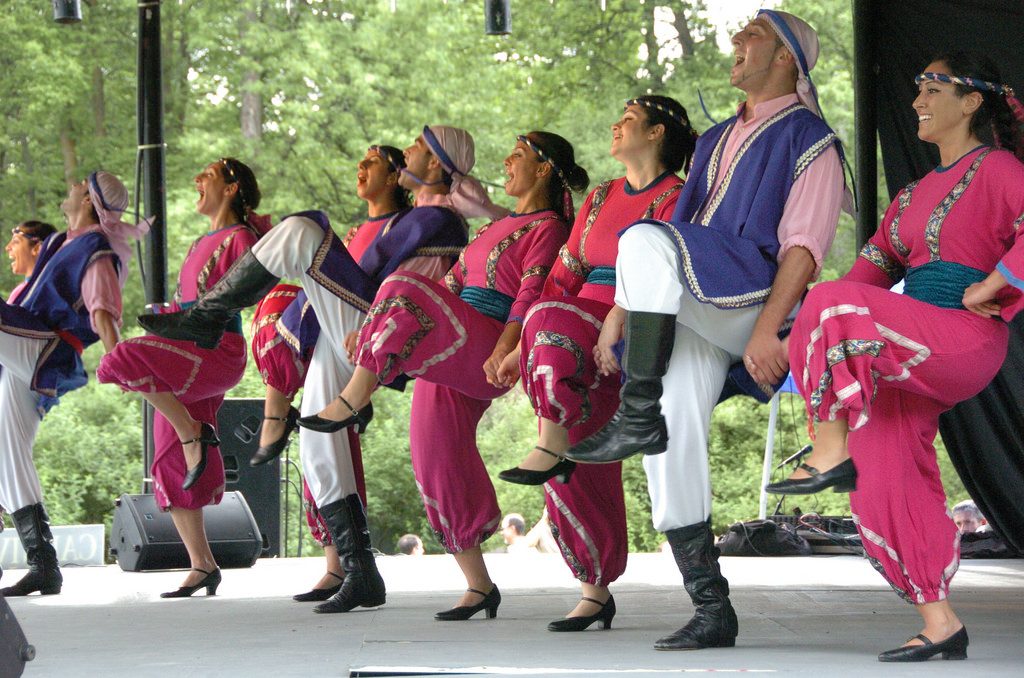 youtube.com/watch?v=G5KfvP4qXa0Canada is home to much dabke https://www.youtube.com/watch?v=tZcuhZa0rns
youtube.com/watch?v=G5KfvP4qXa0Canada is home to much dabke https://www.youtube.com/watch?v=tZcuhZa0rnsHow to Dabke –
Al-Shamaliyya type?The Wikipedia description (above) of Al-Shamaliyya (الشمالية) fits what is by far the most prevalent type of dabke found on YouTube, so I’m assuming that when Levanitne YouTubes teach dabke, they’re teaching Al-Shamaliyya. It’s also possible that only scholars refer to types of dabke.
Basic Lebanese steps https://www. youtube.com/watch?v=K1XbND-e-9QSome simple Palestinian line moves https://www.youtube.com/watch?v=KWWHGdgjEbEPalestinian basic, saba, mijwez moves. https://www.youtube.com/watch?v=Xeo3DHnsdxc&t=206sSome fancy Palestinian in-line steps.
youtube.com/watch?v=K1XbND-e-9QSome simple Palestinian line moves https://www.youtube.com/watch?v=KWWHGdgjEbEPalestinian basic, saba, mijwez moves. https://www.youtube.com/watch?v=Xeo3DHnsdxc&t=206sSome fancy Palestinian in-line steps. Index is below. https://www.youtube.com/watch?v=JJIx5Nbw8e4
Index is below. https://www.youtube.com/watch?v=JJIx5Nbw8e4Leader (
lawweeh) moves Some simple Lebanese leader’s steps. https://www.youtube.com/watch?v=AkukpzPHTnQ More lawweeh moves. https://www.youtube.com/watch?v=pCYl-S5qR0gShayyel series
Here’s an entertaining series, each YouTube teaches a different step.
Be sure to turn on the subtitles by clicking on the red line under the CC ikon.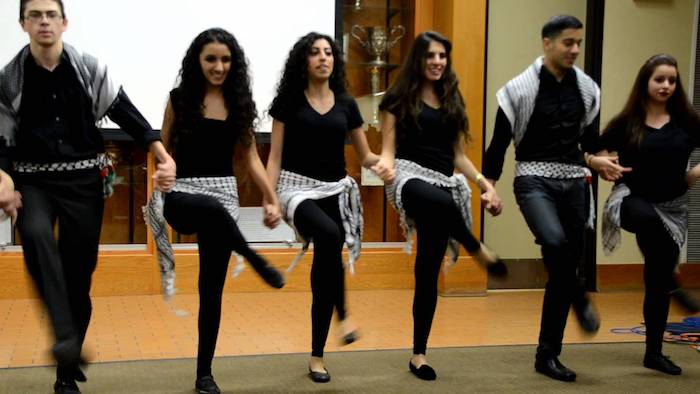
2. Kalashnikov https://www.youtube.com/watch?v=y0731ThYWJQ
3. Al Shamali https://www.
 youtube.com/watch?v=g6JjJ9hQDyY 4. With Rhythm https://www.youtube.com/watch?v=5eHmY6fT6dc 5. The Deer https://www.youtube.com/watch?v=QwUEUElaRQU6.
youtube.com/watch?v=g6JjJ9hQDyY 4. With Rhythm https://www.youtube.com/watch?v=5eHmY6fT6dc 5. The Deer https://www.youtube.com/watch?v=QwUEUElaRQU6.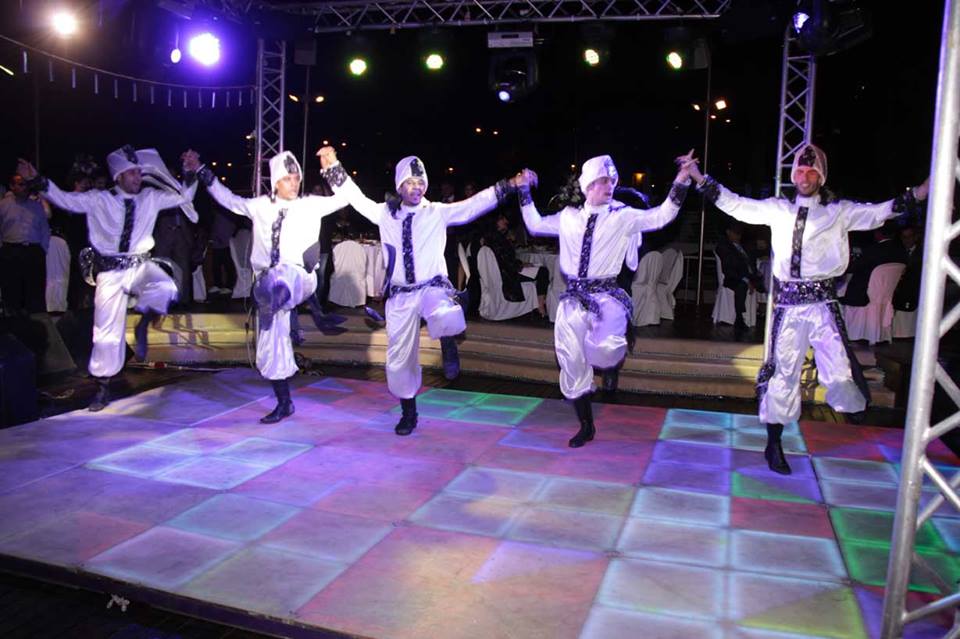 One and a half https://www.youtube.com/watch?v=MMKoaTEcGNM7. Palestinian wedding https://www.youtube.com/watch?v=KYgUChUNItg8. Dazi https://www.youtube.com/watch?v=D-br8oAqKmI9.
One and a half https://www.youtube.com/watch?v=MMKoaTEcGNM7. Palestinian wedding https://www.youtube.com/watch?v=KYgUChUNItg8. Dazi https://www.youtube.com/watch?v=D-br8oAqKmI9. The five https://www.youtube.com/watch?v=6WoD6DxPALg10. The Scissors https://www.youtube.com/watch?v=-BQoJDGX3z4
The five https://www.youtube.com/watch?v=6WoD6DxPALg10. The Scissors https://www.youtube.com/watch?v=-BQoJDGX3z4Like this:
Like Loading...
Dabke Dance: A Shared Tradition of the Levant
by Johanna Sellman
Dabke (also spelled as Dabka) is an Arabic folk dance which originated in the mountains of the Levantine region. This region in the Middle East includes the countries of Palestine, Lebanon, Jordan, and Syria. Dabke is derived from the Levantine Arabic word dabaka (Arabic: دبكة) meaning “stamping of the feet” or “to make a noise”. The Dabke is a dance where everyone stands in a line holding hands facing outwards or to the audience, if there is an audience.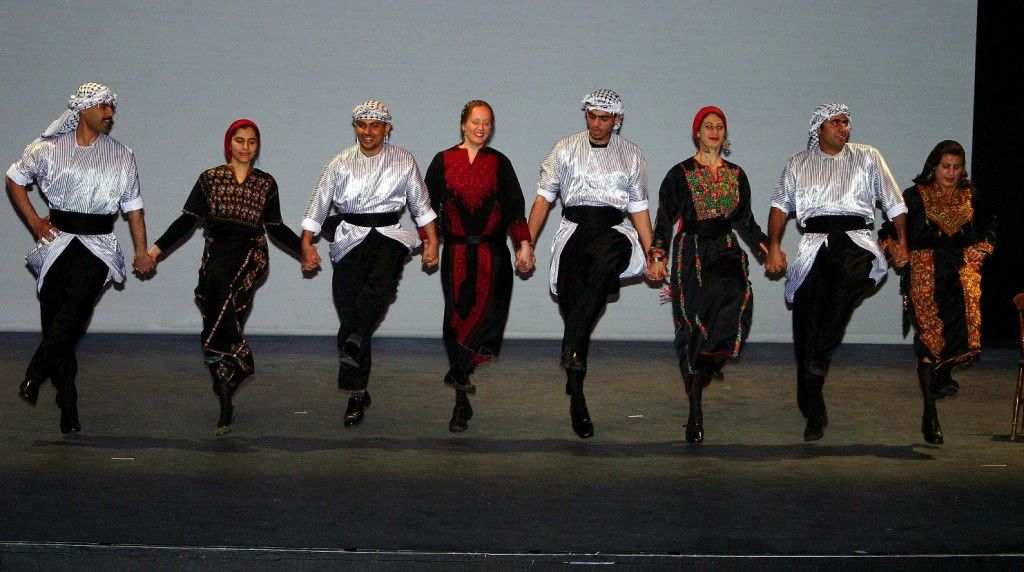 There are many versions of dabke, but the most common one is when the dancers step with the left foot and right foot and then cross the left foot and right foot over. These steps require a small hop as they are done. The dance begins with a song that has a slow introduction in the background, and the dancers start to move together very slowly. When the music begins to speed up, the dancers increase their speed and their footwork becomes more intense. It can get tricky for beginners as the dancers must maintain a synchronized movement- all while keeping up with the same speed as the rest of the group. Usually, the lead person in the dabke is expected to be one of the most skilled in the group of dancers- as he/she is responsible for maintaining the synchronized footsteps and the pace of the group. The leader usually directs the dancers to slow down or speed up and helps keep the energy of the dance. It is very common for the leader to break out of the line by him/herself to do other skilled dances.
There are many versions of dabke, but the most common one is when the dancers step with the left foot and right foot and then cross the left foot and right foot over. These steps require a small hop as they are done. The dance begins with a song that has a slow introduction in the background, and the dancers start to move together very slowly. When the music begins to speed up, the dancers increase their speed and their footwork becomes more intense. It can get tricky for beginners as the dancers must maintain a synchronized movement- all while keeping up with the same speed as the rest of the group. Usually, the lead person in the dabke is expected to be one of the most skilled in the group of dancers- as he/she is responsible for maintaining the synchronized footsteps and the pace of the group. The leader usually directs the dancers to slow down or speed up and helps keep the energy of the dance. It is very common for the leader to break out of the line by him/herself to do other skilled dances. If you have joined a dabke dance or ever watched a dabke performance, you would see something recurring amongst the people in the dabke dance and those around them. Because dabke is a unifying dance, you will always see people randomly joining (breaking a pairs hands to make room for themselves to join) or someone trying to get other members to join. There are many stories on how dabke began. When first created, the Dabke dance was practiced by people of the villages and towns of Lebanon, Syria, Palestine, and Jordan. During those times, the people in these small villages made the roofs of their houses with tree branches and mud. Any weather changes lead to cracking in the mud- often causing leaks and other issues. When this happened, family and community members would come and help patch it by forming a line and joining hands and stomping the mud into place. Over time, the dabka dance was recognized to make the roof work fun. The union of the family and community members was considered a joyful way to keep things in sync and effective.
If you have joined a dabke dance or ever watched a dabke performance, you would see something recurring amongst the people in the dabke dance and those around them. Because dabke is a unifying dance, you will always see people randomly joining (breaking a pairs hands to make room for themselves to join) or someone trying to get other members to join. There are many stories on how dabke began. When first created, the Dabke dance was practiced by people of the villages and towns of Lebanon, Syria, Palestine, and Jordan. During those times, the people in these small villages made the roofs of their houses with tree branches and mud. Any weather changes lead to cracking in the mud- often causing leaks and other issues. When this happened, family and community members would come and help patch it by forming a line and joining hands and stomping the mud into place. Over time, the dabka dance was recognized to make the roof work fun. The union of the family and community members was considered a joyful way to keep things in sync and effective. This tradition was passed through generations as a reminder of the importance of family, community, and tradition. We see dabke performances at weddings, and even in the middle of a protest- which is what makes it so special to the hearts of Arabs. As mentioned earlier, dabke is considered a tradition in the Levantine countries. However, the Palestinian people have adopted it into other aspects of their lives. Dabke signifies hope, struggles, and history of the Palestinian people- making it one of the most important cultural forms of art in their culture. During Palestinian dabke, women wear ‘thobes’ (embroidered long dresses) and men wear pants with wide belts and leather shoes. Men cover their heads with a “keffiyeh” (a scarf), and women cover their heads with a veil hanging loose down their backs. Dabke not only joins us in times of happiness and celebration, but also in times of struggle and political resistance. The core origin of dabke is community and family bonding- which is why we get more family members or audience members to join the line as well.
This tradition was passed through generations as a reminder of the importance of family, community, and tradition. We see dabke performances at weddings, and even in the middle of a protest- which is what makes it so special to the hearts of Arabs. As mentioned earlier, dabke is considered a tradition in the Levantine countries. However, the Palestinian people have adopted it into other aspects of their lives. Dabke signifies hope, struggles, and history of the Palestinian people- making it one of the most important cultural forms of art in their culture. During Palestinian dabke, women wear ‘thobes’ (embroidered long dresses) and men wear pants with wide belts and leather shoes. Men cover their heads with a “keffiyeh” (a scarf), and women cover their heads with a veil hanging loose down their backs. Dabke not only joins us in times of happiness and celebration, but also in times of struggle and political resistance. The core origin of dabke is community and family bonding- which is why we get more family members or audience members to join the line as well.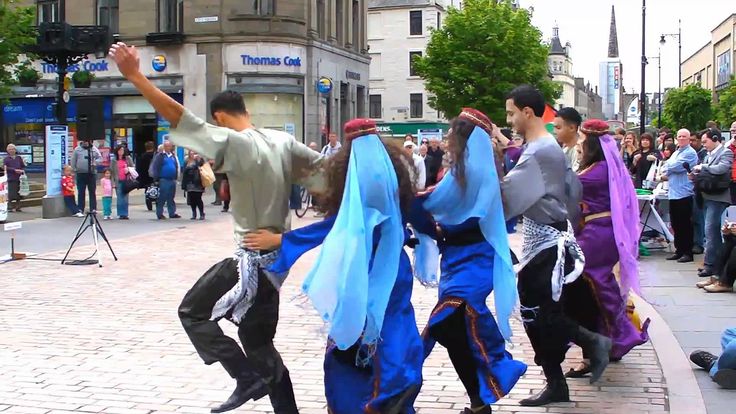 A simple message of locking arms together, stomping to the ground, and singing or chanting has left a deep mark in the culture. Palestinians have taken this to war zones and in the middle of protests because it unifies us against our oppressor. Even when there is a struggle, the dabke dance has given us a chance to look past the political struggle and focus on our traditions and where we come from. The occupation can take the land beneath our feet, but they cannot take the traditions and culture that lives within our hearts. Although the purpose of dabke originated from just repairing the roof of one’s house or a neighbor’s house, it has revolutionized into a symbol of love, life, and struggle.
A simple message of locking arms together, stomping to the ground, and singing or chanting has left a deep mark in the culture. Palestinians have taken this to war zones and in the middle of protests because it unifies us against our oppressor. Even when there is a struggle, the dabke dance has given us a chance to look past the political struggle and focus on our traditions and where we come from. The occupation can take the land beneath our feet, but they cannot take the traditions and culture that lives within our hearts. Although the purpose of dabke originated from just repairing the roof of one’s house or a neighbor’s house, it has revolutionized into a symbol of love, life, and struggle.
Arabic dance Dabq
Traditional Arabic dance Dabq — dynamic, emotional, bright and free. It gives a sense of solidarity, uniting even strangers - often people, having heard their favorite tunes, drop their business and join the dancers.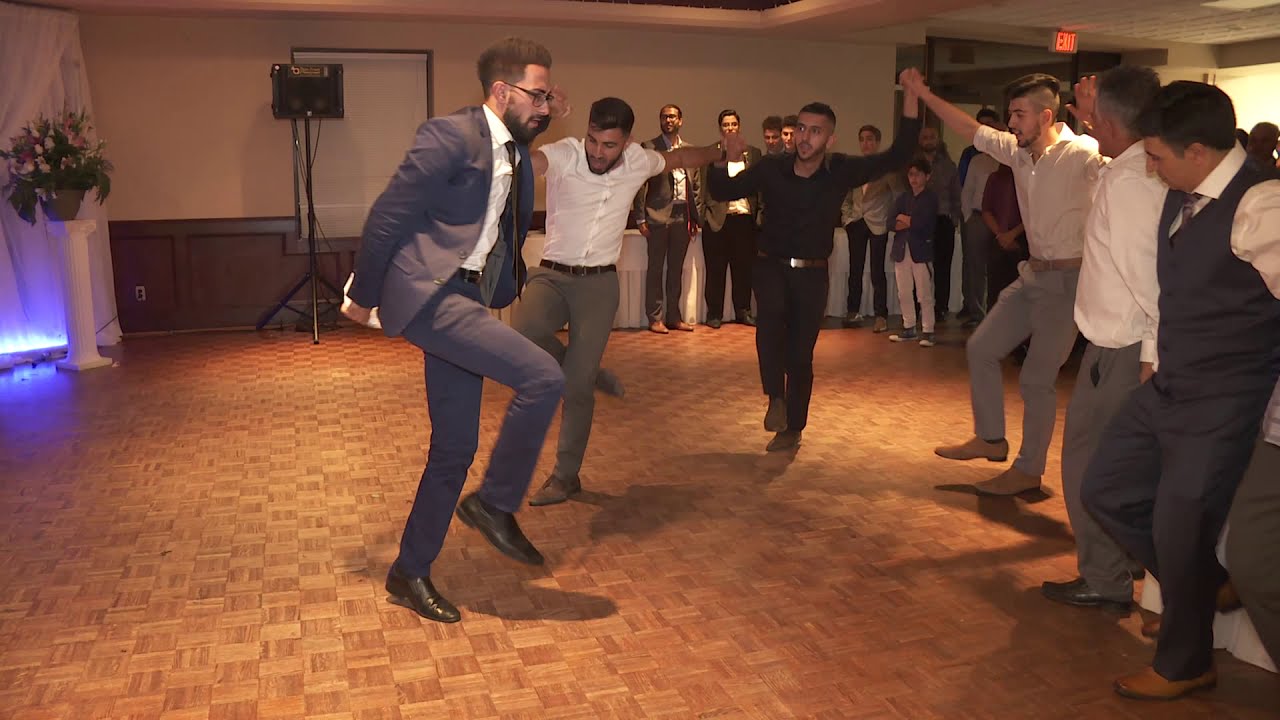 And how to dance dabka, in Lebanon , where it is especially popular, everyone knows from an early age - this dance conveys the spirit of strong friendship of the Lebanese people and charges with a good mood.
And how to dance dabka, in Lebanon , where it is especially popular, everyone knows from an early age - this dance conveys the spirit of strong friendship of the Lebanese people and charges with a good mood.
Dabka is rightly called the Arab step - the dance consists of fast and varied steps, jumps, kicks.
The pace and mood of the whole group is set by the leader - ras (from Arabic "head"), who quickly rotates beads like a rosary in his hand. Instead of a rosary in his hands, there may be a handkerchief weighted with a special weight, a short thick cane, or even a saber. It is believed that his hands characterize the weapon, and with his feet he emphasizes his connection with the earth.
The leader is allowed to improvise, all the other dancers obey him - synchronously repeat energetic movements, keep a single rhythm and cheer each other up with fervent exclamations, lining up in a line of 20-30 people, which gives rise to a feeling of a single whole and an irresistible desire to merge with the dance.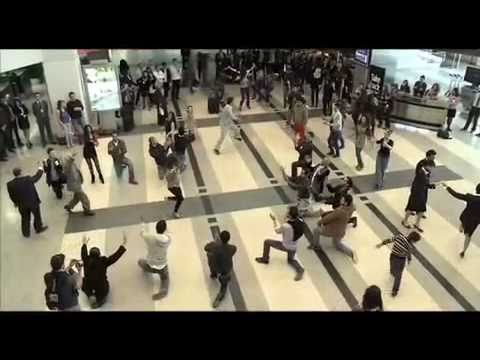 Dabka is so rhythmic and bright that it is hard to sit still while watching the dancers.
Dabka is so rhythmic and bright that it is hard to sit still while watching the dancers.
Dabka is considered a male dance, but can be performed by women as well as by a mixed group. Men dance widely and sharply, their jumps are long and high. Women have more modest movements, and some of them they do not do at all, giving men the right to solo.
The origin of dance.
The Dabka dance originated in Lebanon, and there are a lot of legends about its origin. According to one of them, the dance originated during the construction of houses, when men jointly trampled down thatched roofs. It is believed that in the same way, farmers trampled the earth to make it fertile. Another legend claims that when the Ottoman Empire invaded the territory of modern Lebanon, the inhabitants danced on the roads, breaking them and preventing the Turks from getting from city to city.
There is a version that the origin of the dabka, which is also called the dance of solidarity, was influenced by Turkish culture.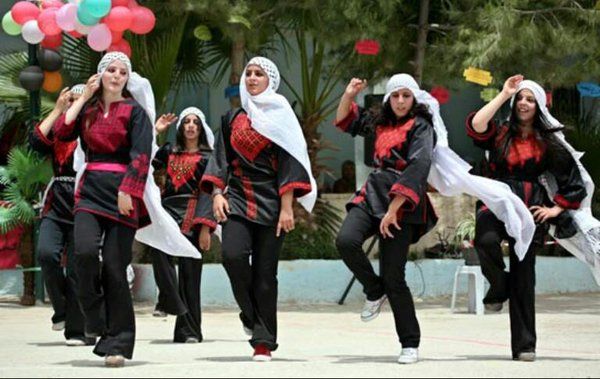 At the same time, Gypsy culture first influenced Turkish culture, and Turkish culture itself, in turn, influenced Arab culture. As proof, the same songs are cited by the Arabs and the Turks. Be that as it may, the dance enjoys great recognition in many Arab countries.
At the same time, Gypsy culture first influenced Turkish culture, and Turkish culture itself, in turn, influenced Arab culture. As proof, the same songs are cited by the Arabs and the Turks. Be that as it may, the dance enjoys great recognition in many Arab countries.
There is no single style of dabka, in each country and even city it has its own presentation, its own character. Syrians, Palestinians, Iranians brought their influence to Dabka, making the dance more diverse.
In Lebanon itself, there are several types of dabka - traditional , Baalbakiya , Badawiyya , Khaizrani (symbolizing the struggle) and others. All of them are very similar to each other and originated from songs with similar names, under which they are performed. During the holidays, the traditional dabka is preferred so that everyone can join the dance.
For the first time on stage, a dabka was performed as part of an international festival in Baalbek in 1960 , and this was preceded by a request from the Lebanese President Camille Chamoun to the famous Russian choreographer Igor Moiseev , so that he, having studied the steps of the dabka, would establish a classical basis for dance.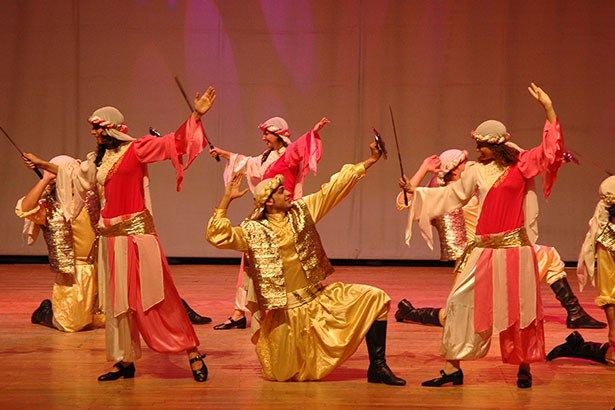 So, thanks to the Russian choreographer, the dubka became popular. Subsequently, the dance was modernized by the Lebanese brothers-composers Assi and Mansour Rahbani .
So, thanks to the Russian choreographer, the dubka became popular. Subsequently, the dance was modernized by the Lebanese brothers-composers Assi and Mansour Rahbani .
In 2007, a world record was set in Palestine - the longest dabka round dance out of three thousand people!
Music .
Dabka is a very temperamental and incendiary dance, with its "hot" rhythms that does not leave any spectator indifferent.
Music for dubka is groovy and fast with a four-quarter rhythm. This is a folklore rhythm often used in Lebanon, Syria and Iraq. The rhythm in three-quarters can also be less common, which is explained by Turkish influence. The dance is accompanied not only by music, but also by a song with male vocals.
Dabka musicians play the darbuk (tabla), an ancient percussion instrument, a small goblet-shaped drum; rebabe - a one-stringed instrument, and the melody is played by a mizmar - a folk wind instrument.
According to one version, the dance could get its name from - darbuki ("darba" - from Arabic "hit"). The darbuka is the solo instrument in the dub, while the tablist who plays it also participates in the dance.
Traditional costume.
As a rule, the colors of clothes are matched to match the national flag of the country. In Lebanon it is red and green. Costumes are decorated with their own symbols, often crosses are embroidered on them - this is how the dancers show their religious affiliation.
Men dance in a plain shirt, waistcoat and wide trousers ( shiruel ), which are tucked into high boots. A red cap is put on the head - tarboush or a scarf is tied in a special way.
Women's costume is brighter, more complex and varied. This may be borrowing men's clothing; skirt, bloomers or long robe; a blouse with a vest or caftan of medium (or slightly lower) length; apron. Small handkerchiefs can be sewn on the sleeves, and a scarf is necessarily tied on the head. Women dance either in boots or in shoes with small heels. There is also a kind of belt.
This may be borrowing men's clothing; skirt, bloomers or long robe; a blouse with a vest or caftan of medium (or slightly lower) length; apron. Small handkerchiefs can be sewn on the sleeves, and a scarf is necessarily tied on the head. Women dance either in boots or in shoes with small heels. There is also a kind of belt.
Nothing reflects the culture of the people like their dances, and the dabka lives in the very soul of the Lebanese. Even the modern youth of Beirut in jeans and sneakers familiar to everyone, holding hands to the thundering rhythm of the DJ, loves to perform their national dance at real dab-parties in nightclubs.
Text: Grishina Julia
Dabka. Oriental dance styles. Dabke. Music. Costume.
DABKA
Dabka ( Dabke ; from " dabke " - stomping feet) - dance style , performed on the Mediterranean coast. Dabka will be performed in Lebanon, Syria, Afghanistan, Turkey, Iraq, Kurdistan and other countries. There are dances similar to dabka performed by the peoples of Greece, the Caucasus and the Balkan Peninsula. In Egypt, they also perform dabki , but as a show or a Bedouin version.
Dabka will be performed in Lebanon, Syria, Afghanistan, Turkey, Iraq, Kurdistan and other countries. There are dances similar to dabka performed by the peoples of Greece, the Caucasus and the Balkan Peninsula. In Egypt, they also perform dabki , but as a show or a Bedouin version.
Traditionally, dabs were performed on holidays, as well as at the most important events of life: wedding, birth of children, seeing off to the war and meeting after it. Lebanese dabka is considered to be the most famous in the world. Let's talk about the Lebanese dabka .
Dabka is that kind of dance of the Arab world, which has several places of origin and is danced differently everywhere.
The basic dabka rhythms sound like "so-dum-dum-dum-so" or "so-dum-so-dum-so"
An old man appears with a darbuk in his hands, and several men with different flutes.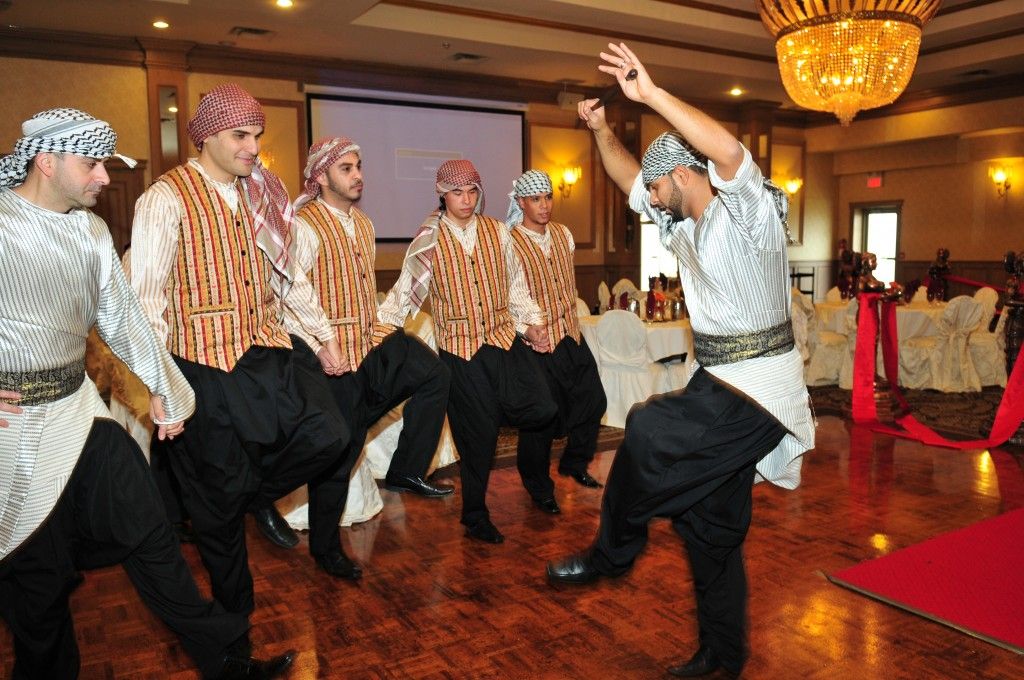 music starts playing. Immediately, several men and women jump up, join hands, and begin to dance, the rest clap in time with the dancers. A woman with a pitcher on her head joins them, competing with them. Then men with swords appear, imitating a battle in a dance. Periodically, a dancer comes out of the line to the center to show how skillful he is in this dance . All of this is a celebration of the vine harvest season that continues in the Lebanese countryside to this day.
music starts playing. Immediately, several men and women jump up, join hands, and begin to dance, the rest clap in time with the dancers. A woman with a pitcher on her head joins them, competing with them. Then men with swords appear, imitating a battle in a dance. Periodically, a dancer comes out of the line to the center to show how skillful he is in this dance . All of this is a celebration of the vine harvest season that continues in the Lebanese countryside to this day.
There are several stories about the origin of dubka . The most common of them. Previously, the Lebanese covered the roofs of their houses with tree branches mixed with straw and mud. If all this is badly compacted, in winter, during the rainy season, cracks could form, and dirt began to flow into the house. The owner of the house called relatives and friends to help make the roof. They joined hands, formed a line and trampled all this mixture with their feet, walking along the roof. For more rhythmic movements, and in general, to make the process more fun, they introduced music and singing. Darbuka and mijuiz (flute) became the main instruments for dubs .
For more rhythmic movements, and in general, to make the process more fun, they introduced music and singing. Darbuka and mijuiz (flute) became the main instruments for dubs .
Another story of the origin of this dance tells that during the rule of the Ottoman Empire in the territory of Lebanon, the inhabitants, in protest, took to the roads and trampled them to destroy, thereby preventing the Turkish soldiers from reaching their shelters.
Another interesting story. Lebanese farmers jumped up and trampled the land to make it more fertile.
There are also several theories about the origin of dubs was influenced by Turkish culture, which in turn was influenced by Gypsy culture. As proof of this, they give an example of identical songs. Arabic "Ala Ain Moulayiteen", has a Turkish gypsy counterpart "Shashkin".
It is also a dance of solidarity and a way to express nationalism. The leader of the dabka should be like a tree. Proud, with hands in the air, characterizing weapons, and feet that trample the ground, thus emphasizing his connection with it. The meaning of dabq in Arabic is "stomping feet". Stomping, as well as jumping and kicking, are steps that characterize dubs in a unique way. The leader, who is called "ras", which means "head", is allowed to improvise at dance , and he or she also twirls a handkerchief or string of beads known as masbha (like a rosary) while the rest of the dancers keep the rhythm. The dance also uses vocals to show energy and punctuate the rhythm. Later, a tablist joined the dancers, a person who dances along with everyone, but at the same time also beats a big drum, called - tab.
The meaning of dabq in Arabic is "stomping feet". Stomping, as well as jumping and kicking, are steps that characterize dubs in a unique way. The leader, who is called "ras", which means "head", is allowed to improvise at dance , and he or she also twirls a handkerchief or string of beads known as masbha (like a rosary) while the rest of the dancers keep the rhythm. The dance also uses vocals to show energy and punctuate the rhythm. Later, a tablist joined the dancers, a person who dances along with everyone, but at the same time also beats a big drum, called - tab.
The most common styles of dabka in Lebanon are Badawiyye, Baalbakiyye, Houwara, Dalouna. All styles originated from songs with similar names, under which dubs . In addition, there is another old style called "Askarieh". In this style , quite difficult steps are performed, and not everyone could dance it. This style was performed in the mid-50s, in the areas - Besharre, Hermel, Akkar and Bekaa.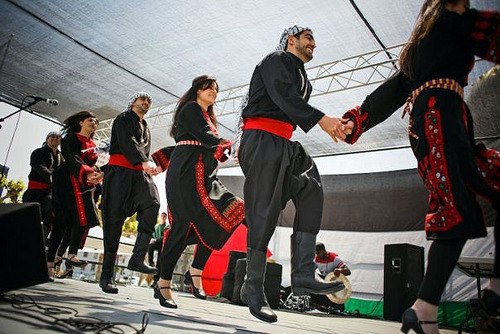 There is also a Hayzrani dub. This is a dance with sticks, symbolizing the struggle.
There is also a Hayzrani dub. This is a dance with sticks, symbolizing the struggle.
Dabka suits
Dabka suit has come down to us in its original form. The country's national colors are red and green. Men dance in wide trousers - shiruel, shirt and vest. A red cap is put on the head - a tarboush or a scarf. Costumes are decorated with their own symbols. Often, crosses are embroidered on the costume, thus showing their religious affiliation. Women's costume is quite diverse, unlike men's. It can be a skirt, and harem pants, and a long robe. Blouse and vest, or caftan of medium or below average length. A scarf that is tied around the head is probably the only obligatory attribute in a women's suit. Small handkerchiefs can also be sewn onto the sleeves. There is also a kind of belt, but each village has its own version suit . Men dance in boots, and women in shoes with small heels, which is better stamped.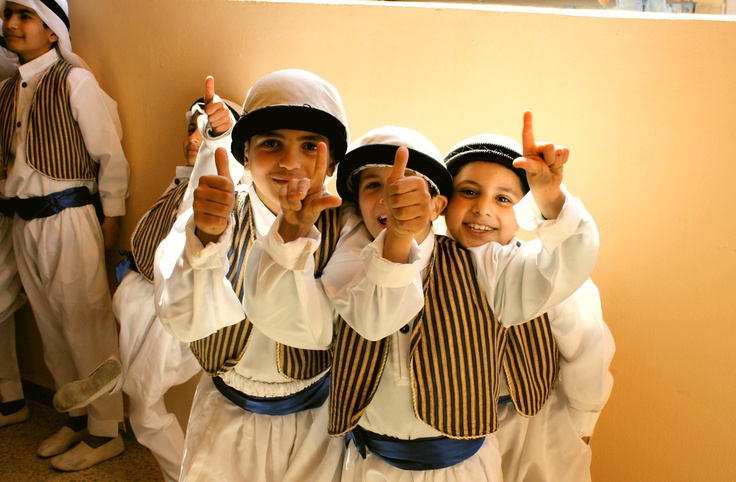
Men, unlike women, dance more sweepingly and sharply. Jumps are longer and higher. At a time when women are doing everything more tightly, squat and more modest. There are some movements that women do not do at all; at this time, they stand on the sidelines and dance when men solo with these movements.
Modern dub
Today, more or less a hybrid of all village variants is performed, which was formulated under the Rahbani brothers for festivals. Dabki are taught from infancy and are danced in every family, gathering for example around a table with Lebanese mazza (a variety of Lebanese snacks), araqam or wine. The dance has undergone changes and has become more lively and varied. Lebanese dabs can be performed separately by both men and women, and both together. It is danced both at weddings and other significant events, and for no reason, just when the mood is good. This dance lives within the Lebanese themselves.